A good friend and heli-oriented customer recently wrote inquiring about a servo gear issue for one of his cyclic servos, but I'll let him speak for himself, and note, we interchanged several emails, and because they are illuminating, I'll present the entire chain . . . after which, we'll meander through a few more topics of interest regarding servo gear trains.
Q. "One of the DS345BLHV servos on my heli is getting harder to turn by hand than the other two servos. He continues, "I have to fold the blades and put them in the holder when I'm done flying for the day (everybody does this, they fold back and stow in a holder thus, riding over the tail boom for travel and storage). He adds, "Typically the servos will move when doing this." (they do move a little bit, won't hurt them). Finishing with, "The servo still performs well, can you share some insight into this?" (he's feeling increased stiffness in one servo and fretting about it, so we address this first).
A. You're always welcome to send it in but my hazarding a guess from 1000 miles away? Well, that just ain't happening! Pick off our address from the bottom of any page of the web site and return the servo for evaluation.

Q. I forgot to ask . . . is this something that's unusual for this type of servo based on my description?
A. I honestly don't know that I've ever heard anyone complain about a servo becoming stiff, but again, send it in for a look see.

Q. I may upgrade from the DS345 to the DS635. I think I'll retire the DS345s unless I can send them in for an upgrade/trade in - lol. Are the DS635BLHV more stout gear train wise than the DS345BLHV? I think the one DS345 has a minor gear train issue causing binding when rotated by hand only in one direction, but they're all developing play. Not so much as to kick them out of bed, but it's there. Are the DS635 less likely to develop user detectable play? I'm also thinking about ordering a DS95BLHV mini from you (this is a tail rotor only servo). Your product listing for mini servos warns to not rotate them by hand but I may have to rotate it occasionally. If I use a deft feel and common sense wouldn't that be OK? Also, is there a coupon code you can share with me?
A. Responding in no particular order; as it happens, it's with a deft touch and common sense that's 'exactly' how you should go about moving a servo attached to a control. So whether it's a main or tail rotor blade, it's both common 'and' OK to do this - as long as you don't force things by playing circus strongman!

Reason you need to be careful is 100% to do with how gear trains in servos are meant to work. Modern high performance servos work using astonishingly high RPM motors compared to servos from back in the day. This, as a consequence, also means they work through very high gear ratios.
That, and the materials are different because their working conditions have changed. More later - but for now - take it as the gospel of John, it's OK to center a control surface, or the front wheel of a truck, or fold back the rotor blades . . . and this absolutely won't hurt the servo!
Where things go wrong is when someone twists away on a servo with the arm, e.g. going back-and-forth repeatedly to 'feel' out the servo. Not sure what in heck they think they can discern, but if you hand someone a servo and it has a servo arm on, then they'll do just this! Anyway, you categorically should 'not' do this to a servo. Like I said, more later.

Regarding servo trade-ins. What, you think we're a Ford dealer? Nothing against that honorable profession but I will say this; if the servo gears need refreshing, then just return the servo(s) for a look-see and we'll be glad to install new gears to bring them back up to snuff.
While we're at it we'll also inspect a few other things. Best part? There's no charge for the extra inspection! Speaking of charges, there's no labor charge, either, so you just pay for the parts.
Can you order gears and do it yourself? Sure - but - you're still better off sending it in because we also inspect the case (using special gauges), and confirm the pot is in spec (with regard to centering), plus we'll lube them, etc.
Anyway, the real point of all this is ensuring you're not farting away the price of new set of gears because if the case is damaged, or worn beyond limits, then installing new gears just means they'll soon be history, once again, OK?
Bottom line with regard to replacing gears, and while I hate to bring it up, sometimes it may not be economically sound to replace just the gears. No, it doesn't happen often - but - for merely the added price of the postage for mailing it in, this strikes me as a very small price to pay for the added peace of mind. But you're a big boy, it's your money, do as you please.

Regarding coupon codes? These would require us to be a company super concerned with marketing. Fortunately (for us) marketing is a luxury someone making the best servos in the business can largely forego. Put another way, we're actually downright lackadaisical about marketing. Also explains why we don't chase down folks who abandon shopping carts, or otherwise bombard you with emails and flyers begging you to buy.
Our view is you know where we are, you know what we make, so if you want them, buy them because if $5-10 is going to make a difference in your life, you really need to take up another hobby. Rant mode off.

Simple Gear Trains
Back to what you're feeling within the DS345BLHV - stiffness. Honestly, this is VERY hard to judge by hand. No offense to you, but what you're feeling may be entirely normal for that particular servo (all your kids share genes yet they all become different as adults, even twins). Same thing with servos, believe it or not.
What's this all mean? Do a Google search on gear trains and you'll inevitably come across an image something like this one.

These two gears comprise what's called a simple gear train, and the difference between this type and a compound gear train has to do with the number of gears and intervening shafts. Note; servos have compound gear trains but let's begin with simple, first.
in the example above, the number of teeth in the gears is expressed as a ratio - meaning compared to 1 (one). The smaller gear is usually called the pinion gear, and a bigger one is termed the ring gear. The math is easy, just divide the number of teeth of the smaller gear into the larger gear and that number is expressed as a ratio.
Let's work through this gear set as an example. Just take the 44 and divide by 15 and it equals 2.93, which as a ratio is written (or expressed) as 2.93:1.
This is almost 3:1 (major point being, the pinion rotates about 3 times to make 1 revolution of the ring gear). Easy peasy, right? Well, it doesn't get much more complex.
So to rotate the ring gear you rotate the pinion gear about three times and this is a lot like riding a bicycle up a hill in low gear. Pedal a lot but the overall effort isn't too high. However, the reverse of this, rotating the ring gear to force the pinion gear to turn, or 1:3 versus 3:1 is a different story.
Keeping with the bicycle theme, remember trying to pedal up a hill in a high gear and how hard this was? Well, it's the same thing with turning the pinion using the ring gear through a 1:3 increase. So yes, you can also force things by rotating the output gear thereby forcing it to turn the input gear but just because it 'can' be done, doesn't mean it should be done.
And there's a downside beyond requiring a lot more effort to force the small gear to turn the big one. This is that if you're not careful, if you input enough force, you can actually break off a gear tooth within your servo. Fact. So this is partly why we caution against it.

Simple gear trains, continued
Let's briefly birdwalk into the subject a bicycle gearing just a little bit. This, because I want to try and tie in something we're perhaps more familiar with (bikes and their gears) to our servos. Specifically, the gear ratio of the servo.
Earlier, when we spoke of bicycles, it's important to note these have a useful gear ratio ranging from about 1:1 (a bit less with some competitive bikes, like an actual overdrive of maybe 0.86:1) through to about 5:1 (as this chart shows).
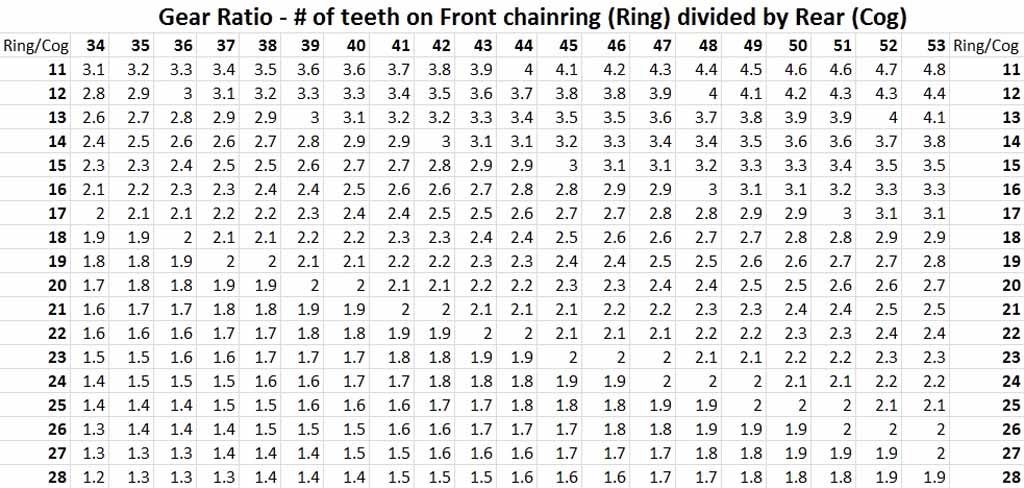
- Bike gear ratios range from as high as 1:1 to as low as 5:1
And note, with bikes, the terminology is similar in that ring gear refers to the big gears on the crank. However, with regard to the smaller gears on the back, while we refer to the smaller gears as a pinion, in the bike world these are called cog gears. Same difference, eh?
Also, a bike does a neat trick in that it uses a derailleur (a mechanism which permits bikes to enjoy variable-ratios). Wouldn't it be nice for a servo to adjust gear ratios depending on the needs, e.g. a lot of grunt - or - a lot of speed? Note, this is 'the' tradeoff' in all gear design, torque for speed, or more speed at the expense of torque. Physics.
In fact, a variable ratio servo could be done (think automatic transmissions in cars) but it would come at the expense (literally), of cubic money (and added complexity). Fortunately, we can do this to our satisfaction with one-off servos (meaning we pick and choose specific servos to accomplish the mission). This, is exactly why our range of standard size servos, for example, go from 90oz-in through 1155oz-in.
Also take note the above chart takes the liberty of rounding the values so if you eyeball 44T along the top row, then go down until you encounter 15T in the first column, they report this as 2.9 when we know it's 2.93, OK?

Anyway, the point of all this conversation about bikes and their gear ratios is this; while bikes range from 1:1 (high gear) to 5:1 (low gear, or the one for hill climbing) the DS345BLHV gear ratio is 310:1, which is akin to starting up Pikes Peak, not just in the highest gear of your bike, but with a ratio 60X harder to pedal than the tallest bike gear imaginable!
Where I'm going with this is discerning slight differences in backlash and inertia of a servo with a complex gear train by twisting the output shaft hand is a fool's errand. Not calling you a fool, just saying please return the servo to us for evaluation by our techs. Considering what crashing your heli may cost, sure the return postage cost for a servo is in a class with lunch-money . . . you take my meaning?

Over-stressing the structure
Another factor are the pockets where the gear shafts are fitted. Forcing the servo by hand means they may get overloaded also, or over-stressed. This, despite the fact we reinforce these pockets with bronze or steel inserts.
What I'm saying is you just cannot wail away on the servo gear train by forcing it to operate in reverse with abandon, understand? Note; and if you do this, and break the servo, then it's hardly fair to ask us to repair it under warranty, capice? Kindly consider this a fair warning about being stupid.

Complex gear trains
So in one direction, the small gear uses mechanical leverage to turn the big gear, and the other way around, while you can force the big gear to spin the small one, it takes a lot effort. Yet what works for a bike (because humans are strong so using a big gear to turn the small cog gear is why we can go fast), that's at 3:1 so imagine how hard it is on the gear train when it's 310:1, instead!
So how do we get from 3:1 with a simple gear train to over 300:1 without the ring gear getting to be as large in diameter as a basketball? This is achieved with several gears in what's termed a compound gear train. When you look inside a servo, the layout looks something like this.
Follow the flow of power in this diagram because it's very much like what's going on inside your servo. Also, look closely and you'll see the small gear always drives a larger gear, so the flow of power is from pinion to ring, which often has a pinion attached for driving another ring, etc.
And note; answering the basketball query, it's through compound gear train arrangements that engineers keep things compact.
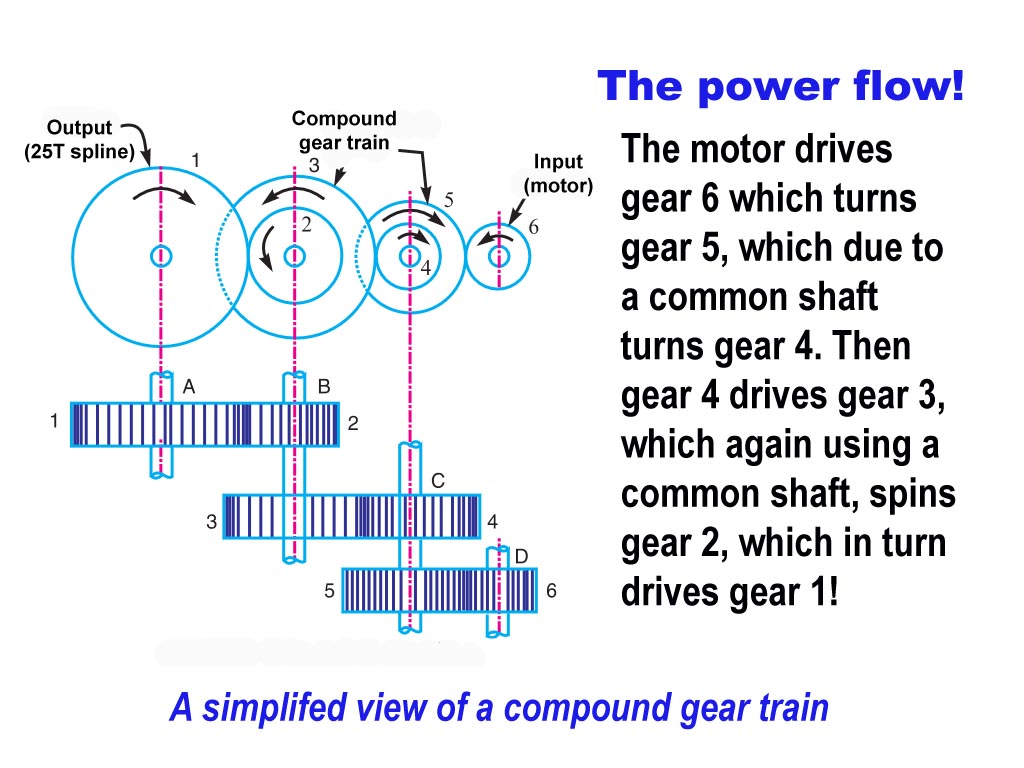
With a compound gear train, the flow of torque takes you through several smaller/larger gear combination. Servos work through ever increasing ratios. But the bottom line is they're designed to operate with the motor pinion driving the gear train to turn the splined output shaft, and NOT with the motor being driven by the output shaft. Please don't force servo output shafts to rotate needlessly, e.g. just for the joy of copping a feel! Just don't.
And look, in all honesty, I'm just as guilty as the next guy of straightening an aileron, or the main rotor blades as I fold them back to stow, thus forcing the servo to operate exactly as it's not been designed, but in common with all experienced modelers, I do it gently. I don't just grab hold and twist to force things. Please do it slowly and gently, not like a gorilla, capice?

Wing loadings and pressure loads
Regarding the gear train of the DS635, yes, the gears in this servo are much larger than those in the DS345. In the below photo, while I'm comparing a DS1155BLHV to a Savox SB-2290SG Monster, the same relationship holds true for the DS535 and the DS345 because the DS345 gears are about the same size as those of the Savox and because the DS635 is one of a family, it means the basic gears are about the same size as those of the DS1155, OK?
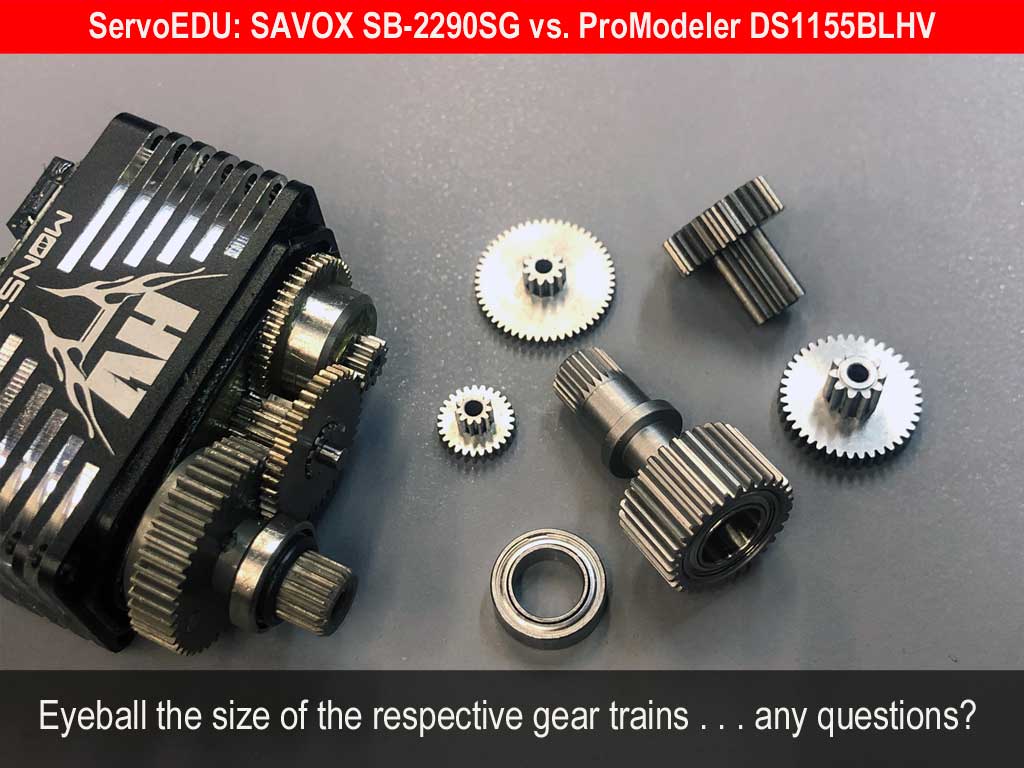
So just like wing loading goes down when the wing is larger, same happens with gear face pressure. So yes, in answer to your question, reduced wear is an immediate benefit of the larger gears of the DS635BHV servo as compared to the DS345BLHV. But not zero wear, that ain't happening - not ever. Why not? Physics, again.
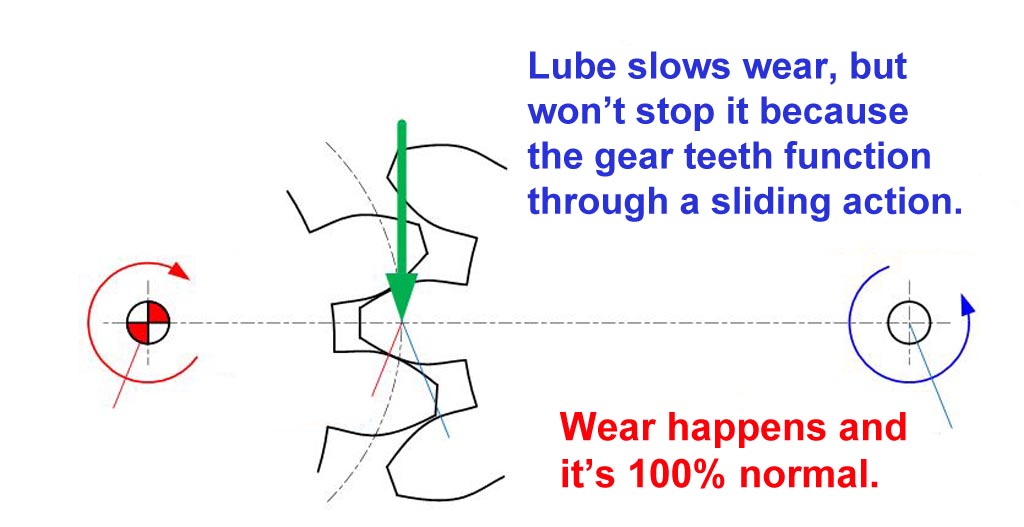
- Plastic gears wear far less quickly than metal gears, but they're weaker.
Basically, gears work with a sliding motion of one face against the other. Sure, lubrication helps but it absolutely doesn't prevent wear. Thus, with respect to gears, whether it's a Ferrari transmission, or the transmission for one of our servos, there's going to be maintenance, eventually.
With regard to returning your servos for service, my advice is yes, send them in for new gear sets. Please don't retire your DS345 just because they require maintenance, send them in for new gear trains because it's very unlikely the motors are worn beyond their service life. Easy peasy, believe me! Especially because there's no labor charge, e.g you only pay for parts!

In this photo, we have a Kraft KPS-14 next to a ProModeler DS360DLHV. The Kraft relied on plastic gears and the ProModeler sports an all metal gear train. Both are compound gear sets and share a near identical layout.
The difference is the Kraft output about 30oz-in versus more than 10X as much, 360oz-in, for the ProModeler. Honestly, the plastic gear train wouldn't last 10 seconds under these kinds of loads. But loaded to less than 30oz-in these gears would last nearly indefinitely while loaded to 360oz-in, the DS360DLHV will need a set of gears after a few years because of the properties of metal that see metal being rubbed away (which is what turns the grease black, just like in used engine oil).
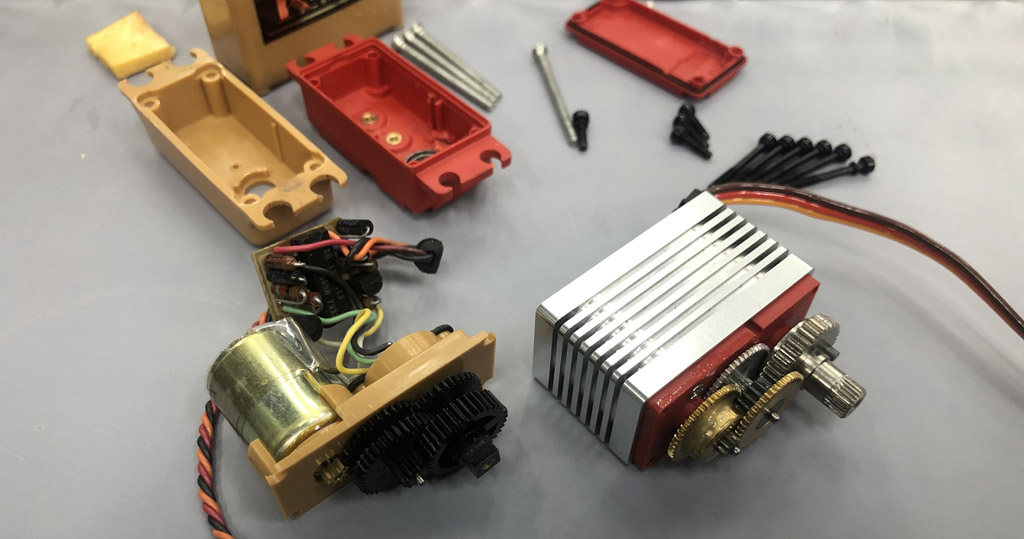
- For old timers, the gold case is the giveaway of the famous Kraft KPS-14

Maintenance, or what you can do to extend gear life
I'm always surprised to receive an expensive servo where the grease is black from use. The guy didn't do squat to maintain them - nothing! Thing is, just like the oil in your car, or the fluid in your motorcycle's transmission, servos benefit from routine maintenance, also. This, otherwise known as clean and lube!
And it's dead nuts simple to do. First, clean the outside of the servo. If they're really dirty, I'll lightly spray them with WD40 and wipe them down with a clean rag. This keeps anything external to the servo from contaminating the inside.
Next, I remove the six machine thread Allen head bolts and set them aside. While you're at it, inspect the o-rings. They don't last forever, they're a maintenance item. This is why we offer replacements. Heads up, eh?
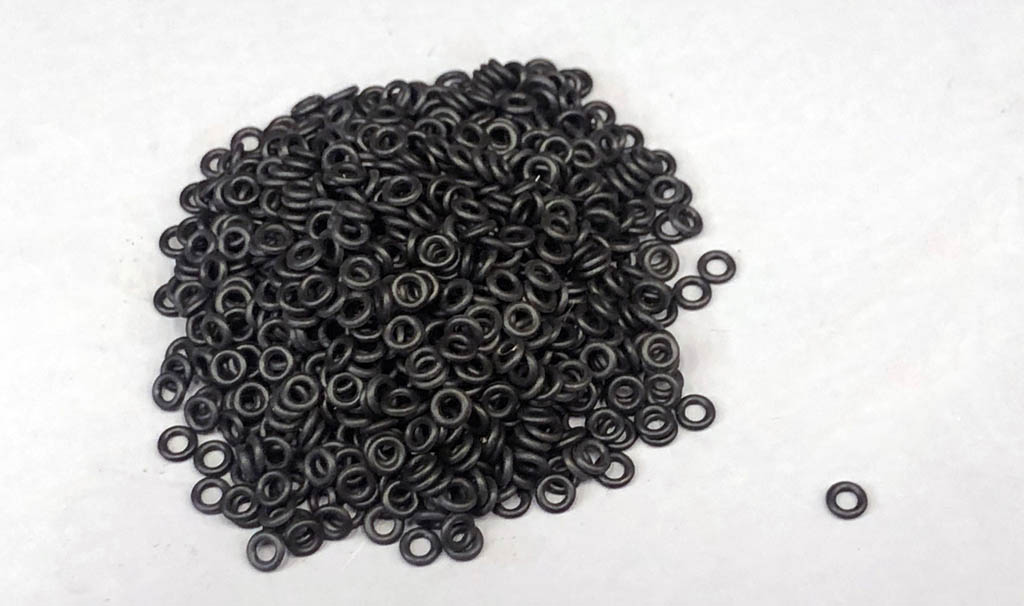
- These are teeny-tiny <2mm ID but photography makes them seem large!
Next, carefully separate the top case from the center case and set the components aside. Begin plucking the gear shafts and gears one by one until you've stripped the servo mechanics down to its component parts.
Look, this isn't rocket science, there's no adjustment between gears or anything so you are just going to clean the bits and reassemble in the reverse order!
When you've got it open it'll look something like this. The bearing will often stay in the case but if it doesn't then remember, someone put it on so it'll come off - but honestly, unless it feels rough I wouldn't bother and for routine maintenance I'd clean a bearing stuck on the output gear shaft in situ and leave well enough alone.
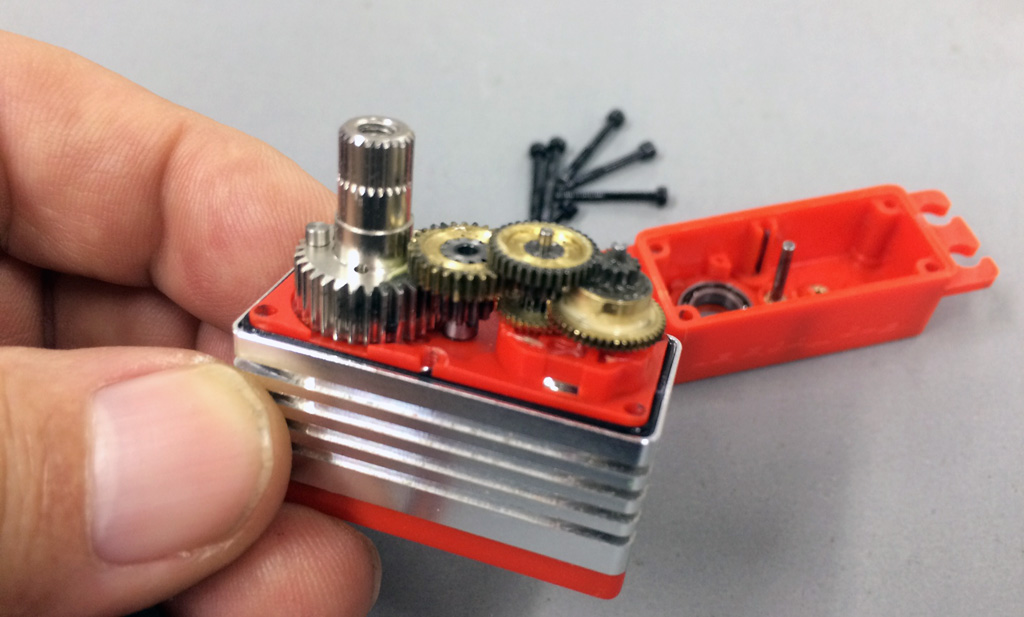
- This DS110CLHV all metal gear train is a work of art - note the inserts
So once you pluck off the gears and shafts you have a bunch of dirty parts in hand, how to clean them? WD40 works well enough. So does gasoline or mineral spirits. Ditto kerosene or lamp oil. In fact, pretty much anything works to clean them off! Even motor oil if that's all you have on hand. It's not critical, believe me. Along with a used toothbrush, a few moments of cleaning will soon see them looking like brand new once again.
So what do they look like when reassembled, and how do you get it right? Well, my advice is you can't go wrong taking a picture of things before you begin. Use your phone! After all, picture and 1000-words, right?
Anyway, this is how they look if you had Superman's X-ray vision. It's a servo render off the CAD workstation. Or what it looks like to me when I'm designing it.
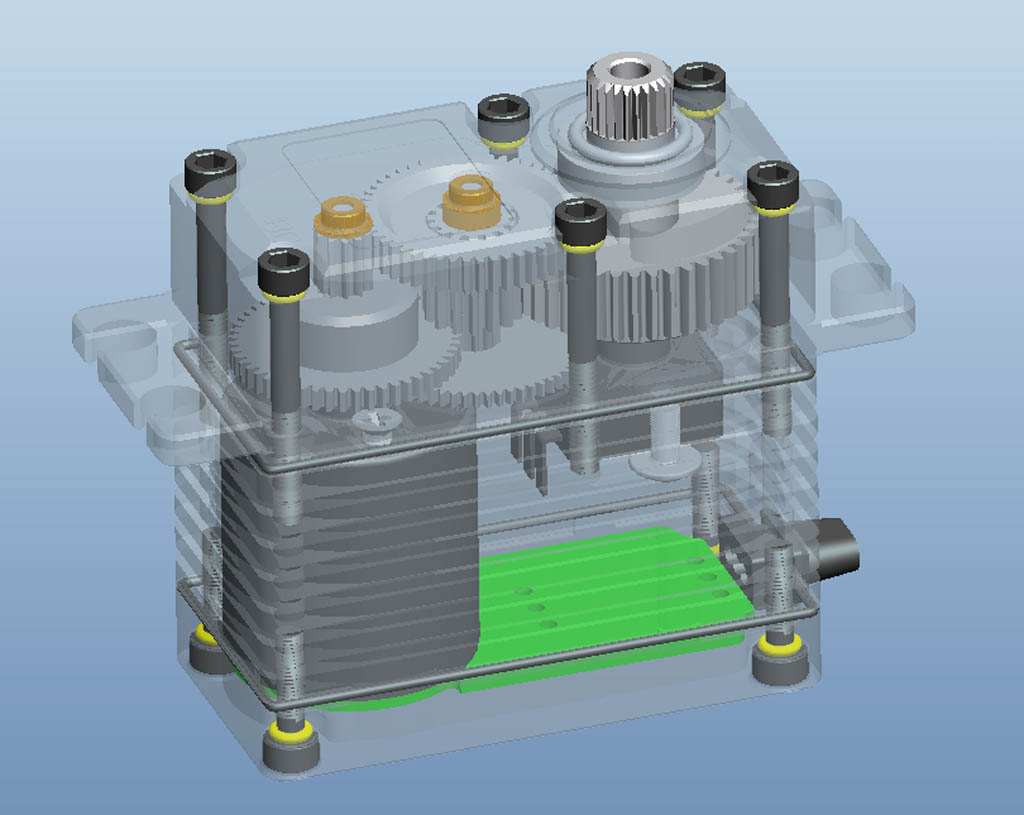
- The yellow under the bolt heads? O-rings. The gold color? Bronze inserts!

So now the next question is, wth what do I lube the gears? Simple, whatever you have on hand. Seriously? No, not hardly, just kidding.
These are very small gear trains. By this I mean using wheel bearing grease meant for your boat trailer is a non-starter because it's too thick. Seriously, that stuff is so thick it'll affect servo performance.
What we use is by Superlube 5W and a 55-gallon drum goes for about $3000 but you don't need this after the gears have broken in. And yes you can go online and buy special lube but my advice is don't bother. Instead, use a light machine oil - Singer sewing machine oil is plenty good enough.
Why a light oil? Because we grease them so as to coat the surfaces during the break in process. Once broken in, a light oil is more than good enough to keep them well lubricated. The reason for a light oil is so it flows in and around the gears.Grease may be flung off and stick to the case but the oil will flow back and be recycled. Trust me.
And yes, servo gears break in just as an engine does (or any other complex machine where parts rub together). And in the process, the part surfaces become smoother for it. Anyway, the loads our servos encounter are relatively light compared to those of a trailer or a car's wheel bearings so instead of a heavy grease, a light machine oil is good enough. And just a drop or two, not much!

So how often should you clean and lube? I service my own servos after the first 10 hours of operation. In the real world, this equates to a flying season. If you fly a LOT then do it midway through the season. Certainly won't hurt anything to do it more often!
Afterwards? About every other years is good enough. That first time the grease will be black, believe me. Subsequently? Not so much. And that''s it. Routine maintenance will often see servos lasting a decade because in fact, they're not loaded to the max all the time.
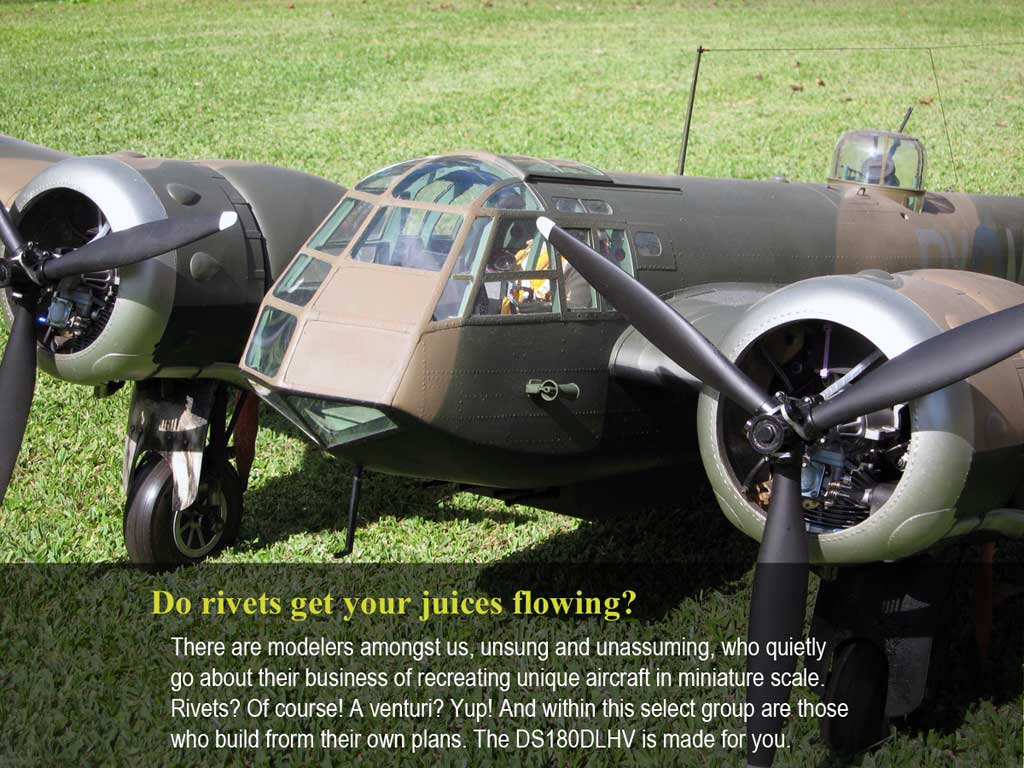
For example, that warbird that weighs 30 pounds and uses DS360DLHV servos won't see more than 300 oz-in of load but a few times during the flight (and you know when, after diving out of the sun and pulling up to perform a victory roll). For a few seconds it see a large load as it pulls up and fights against gravity. The rest of the time? It sees maybe 100-200oz-in. Servo gears will last a loooong time when lightly loaded.
Meanwhile, a crawler is a different story and it's steering servo, often pushing a set of big tires will see very heavy loads - maybe all the time if it's an X-MAXX, or similar. This is why a servo for such rig has an all-steel gear train, even when it's a micro-size 1/18 crawler.
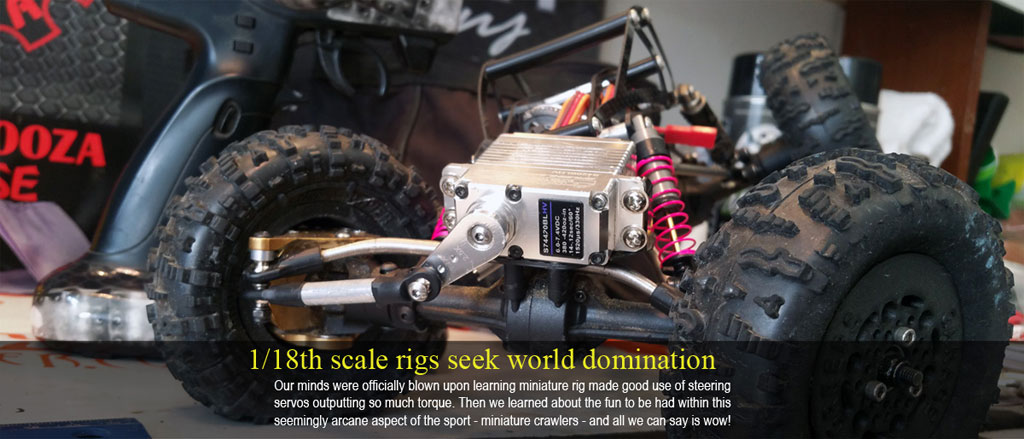
Anyway, if it were me, when it comes to surface rigs I'd be cleaning and lubing the steering servo once a month if I drove it like a stole it. However, if I had eight other rigs to play with, so no one rig got a huge amount of use, then we're back to the one a year, maybe every other year like with model airplanes.
Lot of work to open a servo and do this? Maybe, but it is a hobby, right? After all, we're doing this for fun versus fame and fortune. My point? So what if it requires maintenance frequently? And note, if I played in the creek with it, I'd disassemble it after every single day's fun to blow it out with air and add a bit of lube. Trust me, despite more o-rings and a far higher precision assembly than imports, we never let the words waterproof cross our lips for a reason, eh?
Oh, and with regard to helicopters, what got us started on the topic of servo gear trains in the first place, then it's about the same as for airplanes. E.g. after about 10 hours and then once every year or two afterwards. But if I flew aggressive 3D, then I'd take a peek every 6 months, or so. But for most guys, every other years is good enough.
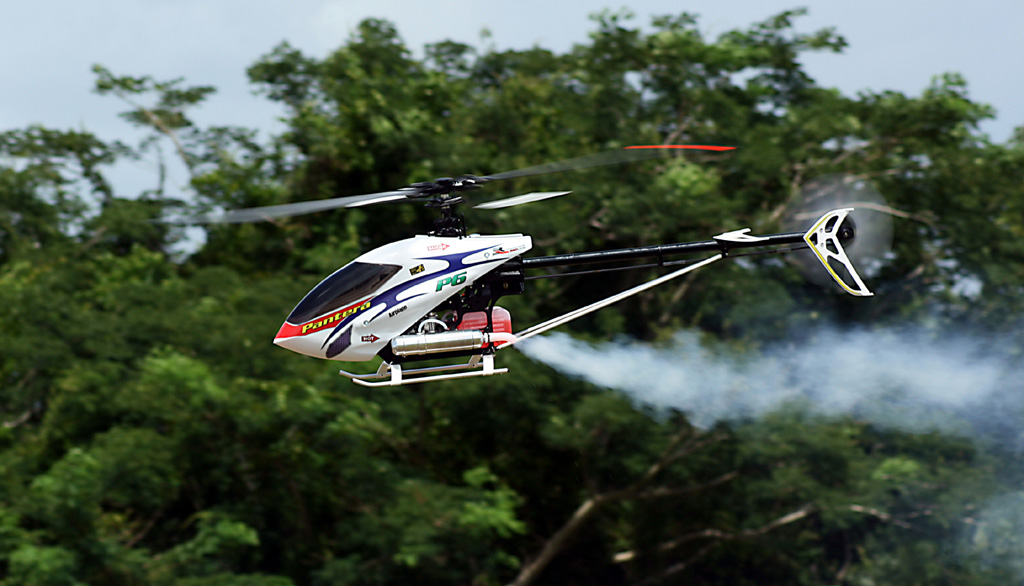
- Pantera P6 - this may be the ideal helicopter with which to learn to fly!

Summary
Send the servos in if you have any doubts. We don't charge for labor. Clean and lube the gear trains after 10 hours, and every two years thereafter. That's about it. Oh, and pinions drive ring gears, compound gears are how we stuff fantastical gear ratios into a tiny amount of space.
So now you now know enough to maintain your servos better than the other guy, like a pro modeler!